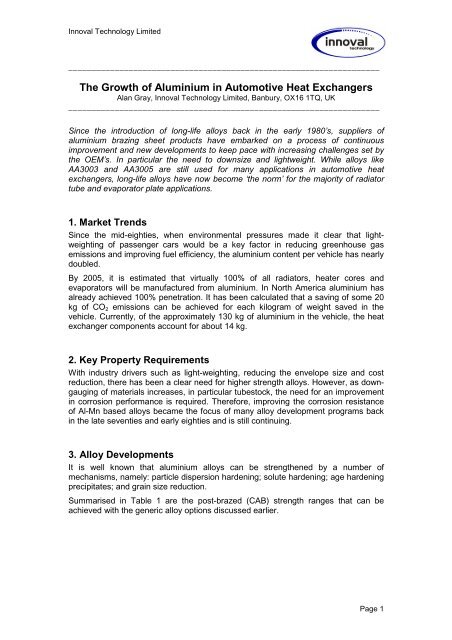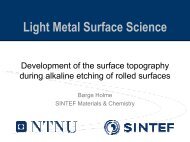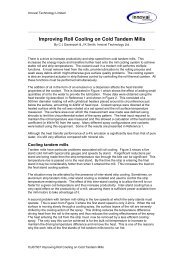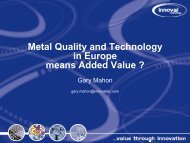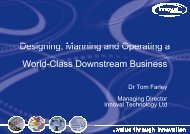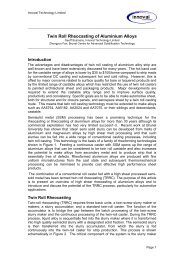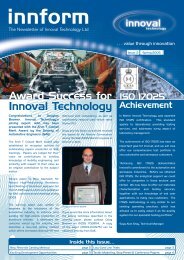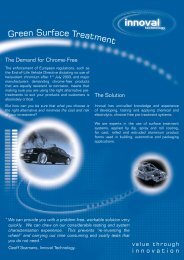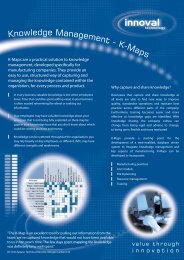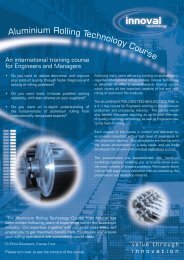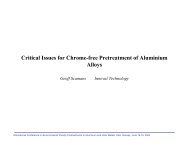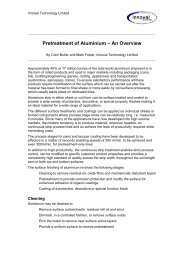The Growth of Aluminium in Automotive Heat Exchangers - Innoval ...
The Growth of Aluminium in Automotive Heat Exchangers - Innoval ...
The Growth of Aluminium in Automotive Heat Exchangers - Innoval ...
You also want an ePaper? Increase the reach of your titles
YUMPU automatically turns print PDFs into web optimized ePapers that Google loves.
<strong>Innoval</strong> Technology Limited<br />
___________________________________________________________________<br />
<strong>The</strong> <strong>Growth</strong> <strong>of</strong> <strong>Alum<strong>in</strong>ium</strong> <strong>in</strong> <strong>Automotive</strong> <strong>Heat</strong> <strong>Exchangers</strong><br />
Alan Gray, <strong>Innoval</strong> Technology Limited, Banbury, OX16 1TQ, UK<br />
___________________________________________________________________<br />
S<strong>in</strong>ce the <strong>in</strong>troduction <strong>of</strong> long-life alloys back <strong>in</strong> the early 1980’s, suppliers <strong>of</strong><br />
alum<strong>in</strong>ium braz<strong>in</strong>g sheet products have embarked on a process <strong>of</strong> cont<strong>in</strong>uous<br />
improvement and new developments to keep pace with <strong>in</strong>creas<strong>in</strong>g challenges set by<br />
the OEM’s. In particular the need to downsize and lightweight. While alloys like<br />
AA3003 and AA3005 are still used for many applications <strong>in</strong> automotive heat<br />
exchangers, long-life alloys have now become ‘the norm’ for the majority <strong>of</strong> radiator<br />
tube and evaporator plate applications.<br />
1. Market Trends<br />
S<strong>in</strong>ce the mid-eighties, when environmental pressures made it clear that lightweight<strong>in</strong>g<br />
<strong>of</strong> passenger cars would be a key factor <strong>in</strong> reduc<strong>in</strong>g greenhouse gas<br />
emissions and improv<strong>in</strong>g fuel efficiency, the alum<strong>in</strong>ium content per vehicle has nearly<br />
doubled.<br />
By 2005, it is estimated that virtually 100% <strong>of</strong> all radiators, heater cores and<br />
evaporators will be manufactured from alum<strong>in</strong>ium. In North America alum<strong>in</strong>ium has<br />
already achieved 100% penetration. It has been calculated that a sav<strong>in</strong>g <strong>of</strong> some 20<br />
kg <strong>of</strong> CO 2 emissions can be achieved for each kilogram <strong>of</strong> weight saved <strong>in</strong> the<br />
vehicle. Currently, <strong>of</strong> the approximately 130 kg <strong>of</strong> alum<strong>in</strong>ium <strong>in</strong> the vehicle, the heat<br />
exchanger components account for about 14 kg.<br />
2. Key Property Requirements<br />
With <strong>in</strong>dustry drivers such as light-weight<strong>in</strong>g, reduc<strong>in</strong>g the envelope size and cost<br />
reduction, there has been a clear need for higher strength alloys. However, as downgaug<strong>in</strong>g<br />
<strong>of</strong> materials <strong>in</strong>creases, <strong>in</strong> particular tubestock, the need for an improvement<br />
<strong>in</strong> corrosion performance is required. <strong>The</strong>refore, improv<strong>in</strong>g the corrosion resistance<br />
<strong>of</strong> Al-Mn based alloys became the focus <strong>of</strong> many alloy development programs back<br />
<strong>in</strong> the late seventies and early eighties and is still cont<strong>in</strong>u<strong>in</strong>g.<br />
3. Alloy Developments<br />
It is well known that alum<strong>in</strong>ium alloys can be strengthened by a number <strong>of</strong><br />
mechanisms, namely: particle dispersion harden<strong>in</strong>g; solute harden<strong>in</strong>g; age harden<strong>in</strong>g<br />
precipitates; and gra<strong>in</strong> size reduction.<br />
Summarised <strong>in</strong> Table 1 are the post-brazed (CAB) strength ranges that can be<br />
achieved with the generic alloy options discussed earlier.<br />
Page 1
<strong>Innoval</strong> Technology Limited<br />
4. Manufactur<strong>in</strong>g Developments<br />
In addition to extensive alloy development programs, some suppliers have developed<br />
novel methods for cladd<strong>in</strong>g onto cont<strong>in</strong>uously cast core alloys and produc<strong>in</strong>g clad<br />
<strong>in</strong>gots <strong>in</strong>-situ. As far back as 1984, Alcan had patented a system for cladd<strong>in</strong>g <strong>in</strong>-l<strong>in</strong>e<br />
on their belt caster (FlexCaster®), and this was followed by Reynolds and Alcoa who<br />
utilised a tw<strong>in</strong> roll caster (TRC) approach to produce clad products. As with all TRC<br />
products, there are still some outstand<strong>in</strong>g issues with products where formability is a<br />
key requirement. In addition to the cladd<strong>in</strong>g on-l<strong>in</strong>e developments, Corus and Alcoa<br />
have developed modified cast<strong>in</strong>g processes to produce clad <strong>in</strong>-situ <strong>in</strong>gots.<br />
5. Future Challenges<br />
Overall, the response <strong>of</strong> the material suppliers to the challenges presented by the<br />
new designs <strong>of</strong> heat exchanger components/systems and government legislation -<br />
‘clos<strong>in</strong>g the technology gap’ – has been good. Without the strength <strong>in</strong>creases and<br />
improvements <strong>in</strong> corrosion resistance, the down-gaug<strong>in</strong>g achievements would not<br />
have been atta<strong>in</strong>able.<br />
However, there still rema<strong>in</strong>s a ‘technology gap’ between the needs <strong>of</strong> the <strong>in</strong>dustry<br />
and current materials performance availability. OEMs will cont<strong>in</strong>ue to encourage<br />
suppliers to produce multi-functional alloys that are stronger and have better fatigue<br />
resistance. Yet, irrespective <strong>of</strong> materials performance, there will always be the<br />
pressure to reduce the manufactur<strong>in</strong>g and raw materials costs. It is easy to foresee<br />
some conflict when the pressure for the recycleability/re-use <strong>of</strong> heat exchanger units<br />
<strong>in</strong>creases at the vehicle ‘end-<strong>of</strong>-life’. One major challenge for the <strong>in</strong>dustry, which<br />
could have a major impact on material costs, is progress <strong>in</strong> the standardisation <strong>of</strong><br />
braz<strong>in</strong>g sheet products used <strong>in</strong> automotive heat exchangers.<br />
Alloy Type<br />
Post-brazed yield MPa & (ksi)<br />
AA3003 & AA3005 35 - 45 (5.1 – 6.5)<br />
Long-life mkI (sacrificial band) 50 – 55 (7.2 – 8.0)<br />
Long-life mkII (sacrificial band) 65 –70 (9.4 – 10.1)<br />
Ultra long-life (sacrificial band + Ti) 55 – 60 (7.2 – 8.7)<br />
Long-life (Ti layer<strong>in</strong>g) 55 – 65 (8.0 – 9.4)<br />
Multiclad 70 – 75 (10.1 – 10.9)<br />
<strong>Heat</strong> treatables (6xxx series) 75 - >85 (10.9 - >12.3)<br />
Table 1 Post-brazed yield strengths <strong>of</strong> braz<strong>in</strong>g sheet alloy variants<br />
Page 2
<strong>Innoval</strong> Technology Limited<br />
Figure 1 <strong>Alum<strong>in</strong>ium</strong> Component Penetration % (US): source: Ducker Research<br />
Figure 1 Downgaug<strong>in</strong>g trends <strong>in</strong> tube and f<strong>in</strong>stock alloys<br />
Page 3


